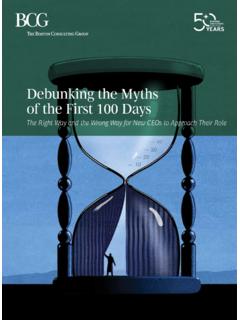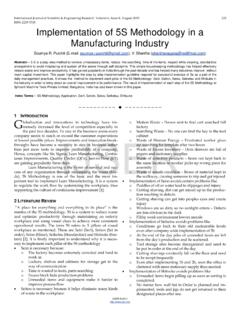Transcription of Industry 4.0: The Future of Productivity and Growth in ...
1 Industry Future of Productivity and Growth in manufacturing IndustriesThe Boston Consulting Group (BCG) is a global management consulting firm and the world s leading advisor on business strategy. We partner with clients from the private, public, and not-for-profit sectors in all regions to identify their highest-value opportunities, address their most critical challenges, and transform their enterprises. Our customized approach combines deep in sight into the dynamics of companies and markets with close collaboration at all levels of the client organization. This ensures that our clients achieve sustainable compet itive advantage, build more capable organizations, and secure lasting results.
2 Founded in 1963, BCG is a private company with 81 offices in 45 countries. For more information, please visit 2015 Michael R mann, Markus Lorenz, Philipp Gerbert, Manuela Waldner, Jan Justus, Pascal Engel, and Michael HarnischIndustry Future of Productivity and Growth in manufacturing Industries2 Industry A GLANCEI ndustry will transform the design, manufacture, operation, and service of products and production systems. Connectivity and interaction among parts, machines, and humans will make production systems as much as 30 percent faster and 25 percent more efficient and elevate mass customization to new ManufacturingManufacturing will be transformed from single automated cells to fully integrated, automated facilities that communicate with one another and boost flexibility, speed, Productivity , and quality.
3 In Germany s advanced manufacturing landscape, for example, Industry can drive Productivity gains of 5 to 8 percent on total manufacturing costs over ten years, totaling 90 billion to 150 Gains in Revenues, Employment, and InvestmentThe impact of Industry will be significant. Our research shows that in Germany alone it will contribute about 1 percent per year to GDP over ten years, create as many as 390,000 jobs, and add 250 billion to manufacturing investment (or 1 to percent of manufacturers revenues). Although the full shift toward Industry might take 20 years to reach fruition, in the next 5 to 10 years key advances will be established and winners and losers will emerge.
4 The Boston Consulting Group 3 Technological advances have driven dramatic increases in industrial Productivity since the dawn of the Industrial Revolution. The steam engine powered factories in the nineteenth century, electrification led to mass production in the early part of the twentieth century, and Industry became automated in the 1970s. In the decades that followed, however, industrial technological advance-ments were only incremental, especially compared with the breakthroughs that transformed IT, mobile communications, and , though, we are in the midst of a fourth wave of technological advancement: the rise of new digital industrial technology known as Industry , a transforma-tion that is powered by nine foundational technology advances.
5 (See Exhibit 1.) In Industry dataand analyticsAutonomousrobotsHorizontal and vertical system integrationCybersecurityAugmentedreality The IndustrialInternet of ThingsAdditivemanufacturingThe cloudSimulationIndustry is the vision of the industrial production of the futureExhibit 1 | Nine Technologies Are Transforming Industrial ProductionSource: Industry transformation, sensors, machines, workpieces, and IT systems will be connect-ed along the value chain beyond a single enterprise. These connected systems (also referred to as cyberphysical systems) can interact with one another using standard Internet-based protocols and analyze data to predict failure, configure themselves, and adapt to changes.
6 Industry will make it possible to gather and analyze data across machines, enabling faster, more flexible, and more efficient processes to pro-duce higher-quality goods at reduced costs. This in turn will increase manufacturing Productivity , shift economics, foster industrial Growth , and modify the profile of the workforce ultimately changing the competitiveness of companies and regions. This report describes the nine technology trends that are the building blocks of In-dustry and explores their potential technical and economic benefits for manu-facturers and production equipment suppliers. To demonstrate our findings, we use case studies from Germany, which is recognized as a world leader in industrial au-tomation.
7 The Nine pillars of Technological AdvancementMany of the nine advances in technology that form the foundation for Industry are already used in manufacturing , but with Industry , they will transform pro-duction: isolated, optimized cells will come together as a fully integrated, automat-ed, and optimized production flow, leading to greater efficiencies and changing tra-ditional production relationships among suppliers, producers, and customers as well as between human and machine. (See Exhibit 2.)From isolated,optimized cells ..to fully integrated dataand product flows across bordersGreater automation will displace some of the least-skilled labor but will require higher-skilled labor for monitoring and managing the factory of the futureMachine-to-machine and machine-to-human interaction enables customization and small batchesIntegrated communication along the entire value chain reduces work-in-progress inventoryExhibit 2 | Industry Is Changing Traditional manufacturing RelationshipsSource.
8 Boston Consulting Group 5 Big Data and AnalyticsAnalytics based on large data sets has emerged only recently in the manufacturing world, where it optimizes production quality, saves energy, and improves equip-ment service. In an Industry context, the collection and comprehensive evalua-tion of data from many different sources production equipment and systems as well as enterprise- and customer-management systems will become standard to support real-time decision making. For instance, semiconductor manufacturer Infineon Technologies has decreased product failures by correlating single-chip data captured in the testing phase at the end of the production process with process data collected in the wafer status phase earlier in the process.
9 In this way, Infineon can identify patterns that help discharge faulty chips early in the production process and improve production RobotsManufacturers in many industries have long used robots to tackle complex assign-ments, but robots are evolving for even greater utility. They are becoming more au-tonomous, flexible, and cooperative. Eventually, they will interact with one another and work safely side by side with humans and learn from them. These robots will cost less and have a greater range of capabilities than those used in manufacturing example, Kuka, a European manufacturer of robotic equipment, offers autono-mous robots that interact with one another.
10 These robots are interconnected so that they can work together and automatically adjust their actions to fit the next unfin-ished product in line. High-end sensors and control units enable close collaboration with humans. Similarly, industrial-robot supplier ABB is launching a two-armed ro-bot called YuMi that is specifically designed to assemble products (such as consum-er electronics) alongside humans. Two padded arms and computer vision allow for safe interaction and parts recognition. SimulationIn the engineering phase, 3-D simulations of products, materials, and production processes are already used, but in the Future , simulations will be used more exten-sively in plant operations as well.














